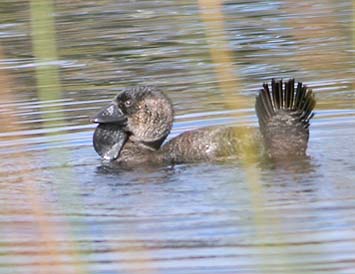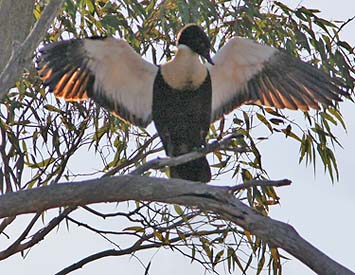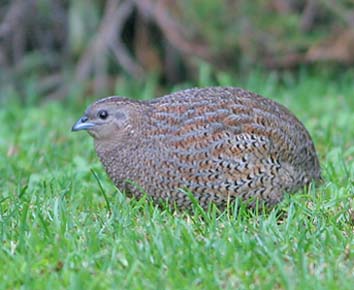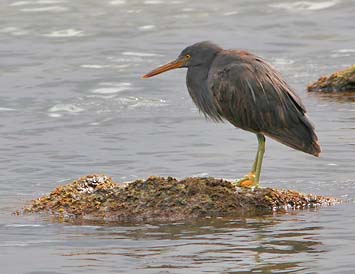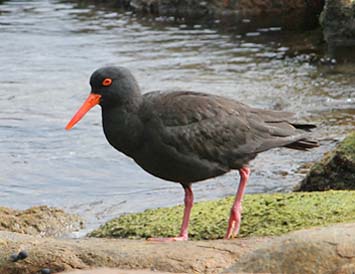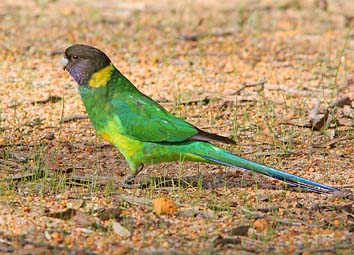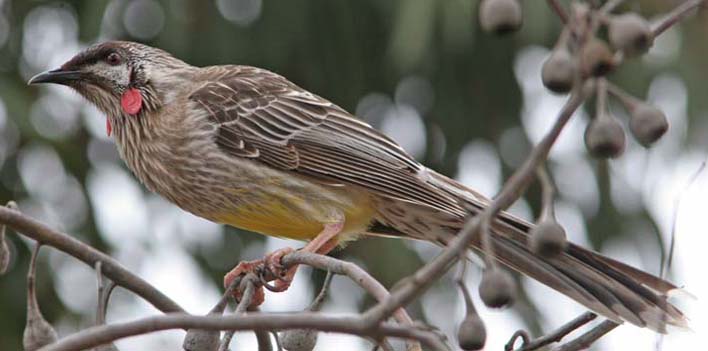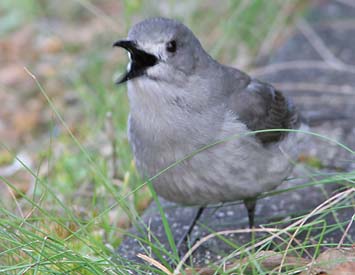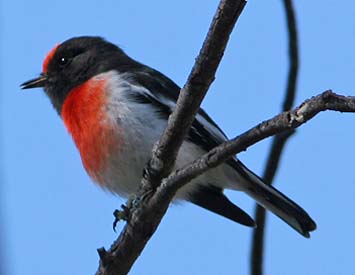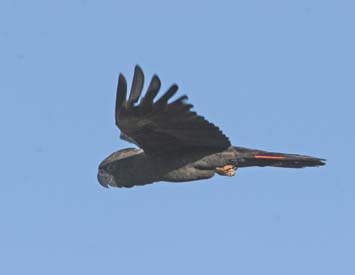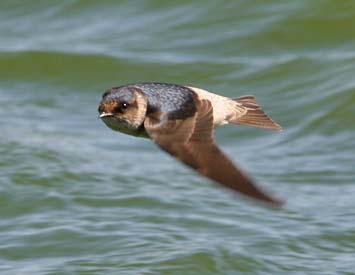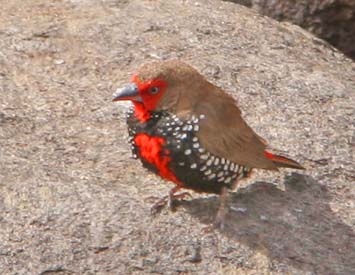| |
SOUTHWEST AUSTRALIA 8-15 August 2008
|
BIRDS
southwestern endemics preceded by an E; near-endemics by NE
Emu Dromaius novaehollandiae: about 20 in the mallee at Fitzgerald River B&B, including some feeding in the farmer's grain
Musk Duck Biziura lobata: ~25 on Lake Seppings in Albany; another near Dunsborough
Black Swan Cygnus atratus: ~50 on Lake Muir; a few more on ponds near Dunsborough
Australian Shelduck Tadorna tadornoides: ~40 on Lake Muir; 1-2 daily in Dryandra Forest, a few elsewhere
Maned [Australian Wood] Duck Chenonetta jubata: a few widely scattered birds, including Dryandra Forest
Australasian Shoveler Anas rhynchotis: 3 on Lake Seppings in Albany
Grey Teal Anas gracilis: 1-2 in Dryandra Forest and from Kalgan River bridge near Albany
Pacific Black Duck Anas superciliosa: widespread in small numbers; many locales
Hardhead Aythya australis: ~8 on the Avon River near Toodyay
Blue-billed Duck Oxyura australis: ~25 on Lake Seppings in Albany
Hoary-headed Grebe Poliocephalus poliocephalus: 3 on Lake Seppings, Albany, and 2 on Avon R. at Toodyay
Malleefowl Leipoa ocellata: a single bird visiting its mound just after dawn at Fitzgerald River B&B
Brown Quail Coturnix ypsilophora: Two daily on the little lawns at Cheynes Beach caravan park
|
|
|
male Musk Duck in display (above)
Rita at Malleefowl mound (below) |
Australian Shelduck in Dryandra Forest (above)
Brown Quail at Cheynes Beach (below) |
|
|
|
Shy Albatross Thalassarche cauta: one scoped from Cape Naturaliste
Yellow-nosed Albatross Thalassarche chlororhynchos: ~15 scoped from headlands at Cheynes Bay & 7 more scoped from Cape Naturaliste in good winds
Great-winged Petrel Pterodroma macroptera: singles scoped from Cheynes Bay headlands & Cape Naturaliste
Huttton's Shearwater Puffinus huttoni :
~300 small dark-and-white shearwaters in the far distance were scoped
from Cape Naturaliste. It was apparent in comparison to gannets, etc.,
and on flight style, that these were very small shearwaters, in the
Fluttering/Hutton's/Little Shearwater set, but the distance precluded
any significant details. In correspondence with Frank O'Connor, he
suggests that only huttoni occurs in these numbers.
Australasian Gannet Morus serrator: ~30 scoped from Cape Naturaliste in high winds
Australian Pelican Pelecanus conspicillatus: there was a roost on an islet visible from the Kalgan River bridge, east of Albany; another was at L. Seppings
Little Pied Cormorant Microcarbo melanoleucos: a few on the Kalgan and Avon rivers, and near C. Naturaliste
Great Egret Ardea alba: 4 on Kalgan R., east of Albany
White-faced Heron Egretta novaehollandiae: singles on Kalgan R., Albany, and Avon R., Toodyay
Eastern Reef Egret Egretta sacra: one on Cheynes Bay
Australian White Ibis Threskiornis molucca: small flocks on Kalgan R. & L. Seppings, Albany; more in fields enroute
Yellow-billed Spoonbill Platalea flavipes: ~15 on the Kalgan R., east of Albany
Black-shouldered Kite Elanus axillaris: a handful seen from car enroute, never more than 1/day
White-bellied Sea-Eagle Haliaeetus leucogaster: 1 in flight at Cheynes Bay
Brown Goshawk Accipiter fasciatus: one perched in Dryandra Forest
Wedge-tailed Eagle Aquila audax: a widespread bird, seen on most days, but typically just 1/day, with 5 in a small area near Fitzgerald River B&B
Little Eagle Hieraaetus morphnoides: one perched at Stirling Range Resort
Brown Falcon Falco berigora: one near Cape Naturaliste
Nankeen Kestrel Falco cenchroides: widespread in small numbers, mostly seen enroute from car
Purple Swamphen Porphyrio porphyrio: one at L. Seppings, Albany
Dusky Moorhen Gallinula tenebrosa: one on Avon River at Toodyay
Eurasian Coot Fulica atra: a couple at L. Seppings and on Avon River, Toodyay
Bush Stone-curlew Burhinus grallarius: a couple had a day roost under a bush in Dryandra Forest
Pied Oystercatcher Haematopus longirostris: 4 on Kalgan River, east of Albany
Sooty Oystercatcher Haematopus fuliginosus: 2-3/day on shores of Cheynes Bay & Two Peoples Bay
[ Black-winged Stilt Himantopus himantopus: Rita saw 4 from the car on the drive back to Perth ]
Pacific Gull Larus pacificus: a few at Cheynes Bay
Silver Gull Chroicocephalus novaehollandiae: regular daily along southwestern coast; also at L. Muir
Great Crested Tern Sterna bergii: daily when scanning ocean at Cheynes Bay & Cape Naturaliste
|
|
|
Eastern Reef Heron (above)
Australian Ring-necked Parrot (below) |
Sooty Oystercatcher (above)
Purple-crowned Lorikeet (below) |
|
|
|
Laughing Dove Streptopelia senegalensis: this introduced dove at Narrogin
Spotted Dove Streptopelia chinensis: this introduced dove near Busselton
Common Bronzewing Phaps chalcoptera: quite common in Dryandra Forest; a few scattered elsewhere
Brush Bronzewing Phaps elegans: 2-4/daily in the Cheynes Beach caravan park
Crested Pigeon Ocyphaps lophotes: fairly common in the mallee around Fitzgerald B&B, a few elsewhere
Red-tailed Black-Cockatoo Calyptorhynchus banksii: small flock at Wungong Gorge
E Short-billed [Carnaby's] Black-Cockatoo Calyptorhynchus latirostris:
large flocks of this or the next species were in Wungong Gorge, but
those seen well were Long-bills; it is possible both species were
there. We had good close at one Short-billed in the Stirling Range, and
another flock there could also have been this species
E Long-billed [Baudin's] Black-Cockatoo Calyptorhynchus baudinii: a flock of 80+ west of Dryandra Forest proved to be this species, as were at least 20 (out of 100) seen at Wungong Gorge
Galah Eolophus roseicapillus: fairly widespread, with 12-20/day often, but not seen every day. Pair checking out a potential nest hole at Armadale
Long-billed Corella Cacatua tenuirostris: a couple with Little Corella south of Freemantle are escapes, I think
E Western Corella Cacatua pastinator: efforts
to find these around L. Muir failed, so on our final day we went
northeast of Perth into the Avon River valley, and found perhaps 100
with Little Corellas near Toodyay
Little Corella Cacatua sanguinea: huge numbers in Avon River valley near Toodyay, where it outnumbered Western by ~4:1
Purple-crowned Lorikeet Glossopsitta porphyrocephala: small flocks common in Dryandra Forest & Stirling Range
Regent Parrot Polytelis anthopeplus: a few south of Narrogin, and daily in Stirling Range
E Western Rosella Platycercus icterotis: a few in Dryandra Forest & Fox Lair, Narrogin; 1-2/daily along southwest coast & Stirling Range, but quite skittish
Australian Ringneck Barnardius zonarius: common and widespread, seen daily (sometimes 40-50/day) except at Cheynes Bay area
E Red-capped Parrot Purpureicephalus spurius: a few daily in Dryandra Forest & Narrogin; also Wungong Gorge
Elegant Parrot Neophema elegans: up to a dozen/day in Dryandra Forest; a few in Stirling Range
Rock Parrot Neophema petrophila: one perched & another in flight at Cape Naturaliste Lighthouse
Southern Boobook Ninox novaeseelandiae: one heard only, at night in Dryandra Forest
Laughing Kookaburra Dacelo novaeguineae:
widespread in small numbers, typically 1-4/day; biggest concentration
was a noisy half-dozen in Porongurup Nat'l Park. These are introduced
to southwestern Australia.
E Noisy Scrub-bird Atrichornis clamosus:
perhaps the most important bird of the trip, we spent hours trying to
see singing males at Cheynes Beach. One had a territory that included
part of the caravan park, but it took hours to see it decently. Most
often seen running across the sandy track between singing perches in
dense bushes. We eventually more-or-less mapped 3 separate territories
of males in the heath at Cheynes Beach, and two more were singing in
Waychinicup Nat'l Park (we did not try to see them)
NE Rufous Treecreeper Climacteris rufa:
fairly common but local in Dryandra Forest (10-15/day). One adult was
feeding young, showing that they breed early in the season. Rita had
another in Porongurup park
Splendid Fairy-wren Malurus splendens: conspicuous at Cape Naturaliste, where a family party fed in the car park; also at Wungong
NE Blue-breasted Fairy-wren Malurus pulcherrimus:
patchy & local in Dryandra Forest; our best views were of a dozen
at arboretum near Ochre Trail. We may have had females/imms at Cheynes
Beach also, but we are not sure
E Red-winged Fairy-wren Malurus elegans: a
few daily at Cheynes Beach & Two Peoples Bay, but most often
females or imms; only a single male seen on 10 August in heath behind
Cheynes Beach caravan park
Southern Emu-wren Stipiturus malachurus:
singing bird in heath between Cheynes Beach did not respond to tape. I
never saw one this trip (I've seen it before), but Rita had one in
heath at Two Peoples Bay
E Western Bristlebird Dasyornis longirostris:
a pair seen in the Little Beach car park just after dawn, where we
first heard the male, then watching them run across to the car park
island, and Don later had one feeding along the edge of the car park
itself. Exceptionally difficult to see when in the heath
White-browed Scrubwren Sericornis frontalis: common and widespread in heath and brushlands
Weebill Smicrornis brevirostris: a few daily in Dryandra Forest; also at Fitzgerald River
Western Gerygone Gerygone fusca: not as common as had been expected, with 3 at Dryandra & 1 at Toodyay
Yellow-rumped Thornbill Acanthiza chrysorrhoa: found at edge habitat in Dryandra; also Fitzgerald River B&B
Western Thornbill Acanthiza inornata: scattered birds from Dryandra to Cheynes Beach to Porongurup & Stirling Range
Inland Thornbill Acanthiza apicalis: a few in the undergrowth at Dryandra Forest
Striated Pardalote Pardalotus striatus: several in woods at Porongurup Nat'l Park; Rita saw some at Two Peoples Bay |
|
White-browed Scrubwren (above) in Dryandra Forest
|
|
E Western Spinebill Acanthorhynchus superciliosus:
these really spiffy birds were in mixed flocks in Dryandra Forest
(3/day on 2 days), at Cheynes Beach (Rita only), and a pair was
nest-building around a car park at Two Peoples Bay, with the male
regularly attacking his own image reflected in our car window
Singing Honeyeater Lichenostomus virescens: common in Dryandra Forest
White-eared Honeyeater Lichenostomus leucotis: a couple in Dryandra Forest
Yellow-plumed Honeyeater Lichenostomus ornatus: common in Dryandra Forest & Stirling Range
Yellow-throated Miner Manorina flavigula: common around Fitzgerald River B&B; one at Stirling Range
E Western Wattlebird Anthochaera lunulata: fairly common in Dryandra Forest, where we saw males in full display; a few others elsewhere
Red Wattlebird Anthochaera carunculata: common, conspicuous and widespread throughout
Tawny-crowned Honeyeater Glyciphila melanops: daily in the mallee at Fitzgerald River BB; also Stirling Range and Cape Naturaliste
Brown Honeyeater Lichmera indistincta: the abundant honeyeater in Dryandra Forest & vicinity; one at Stirling Range
New Holland Honeyeater Phylidonyris novaehollandiae:
the common honeyeater at most locales in open country (mallee,
southwest coast heath, gardens) but fewer inside Dryandra Forest
White-cheeked Honeyeater Phylidonyris niger: several in the motel garden at Narrogin; common at Cheynes Beach
Brown-headed Honeyeater Melithreptus brevirostris: one with a mixed flock in Dryandra Forest
White-naped Honeyeater Melithreptus lunatus: a few in Dryandra Forest; common at Porongurup park
|
| |
Red Wattlebird (above) at Narrogin
Gray Shrike-Thrush at Stirling Range (below left), Red-capped Robin at Dryandra (below right)
|
|
|
|
White-browed Babbler Pomatostomus superciliosus: a couple in Dryandra Forest, one at Fitzgerald River B&B
Black-faced Cuckoo-shrike Coracina novaehollandiae: small numbers most days
Grey Shrike-thrush Colluricincla harmonica: more heard than seen, but reasonably common at Dryandra Forest & in Stirling Range
E Western Whipbird Psophodes nigrogularis:
we used a tape to call one in at Fitzgerald River B&B, but the view
was of him flying across the road. We could never spot him singing in
the thick mallee.
Golden Whistler Pachycephala pectoralis: a few in Dryandra Forest, plus Fitzgerald River, Two Peoples Bay, Stirling Range
Australian Magpie Cracticus tibicen: common and widespread
Grey Currawong Strepera versicolor: common and widespread, although numbers not as high as magpies
Dusky Woodswallow Artamus cyanopterus: a couple daily in Dryandra Forest; rather common around Stirling Range Resort
Australian Raven Corvus coronoides: widespread and common (30-50/day most days)
Magpie-lark Grallina cyanoleuca:
widespread; basically found everywhere except Cheynes Beach. This
unique bird, once placed in its own family, is actually a monarch
Grey Fantail Rhipidura albiscapa: common in Dryandra Forest; widespread in smaller numbers elsewhere
Willie Wagtail Rhipidura leucophrys: fairly common in Dryandra and on southwest coast, Wungong, Toodyay
Restless Flycatcher Myiagra inquieta: this bird has unexpectedly cool vocalizations; found in Dryandra Forest and Stirling Range
Scarlet Robin Petroica boodang: two males & a female in Dryandra Forest; a half-dozen in euc woods at Porongurup park, also Stirling Range
Red-capped Robin Petroica goodenovii: found by following a mystery call in Dryandra Forest, two males were seen there
NE Western Yellow Robin Eopsaltria griseogularis:
four seen on our final day in Dryandra; but also found at Fitzgerald
River B&B, at Stirling Range & Porongurup park, and at Cape
Naturaliste
E White-breasted Robin Eopsaltria georgiana:
tame along the southwest coast: a few daily (1-4/day) from Cheynes
Beach to Cape Naturaliste, and in Stirling Range & Porongurup park
Welcome Swallow Hirundo neoxena: locally common around lakes, rivers, coastline
Tree Martin Petrochelidon nigricans: one in Dryandra Forest (just arriving?), common at Stirling Range
Southern Scrub-robin Drymodes brunneopygia: one singing at Fitzgerald River B&B was tracked down
Silvereye Zosterops lateralis: widespread; common (up to 50/day) at Cape Naturaliste, Stirling Range, Wungong, Toodyay
Common Starling Sturnus vulgaris: introduced around Sydney
Australasian Pipit Anthus novaeseelandiae: one in field at Fitzgerald River B&B
109
species in southwestern Australia, plus Rita had one I missed, for a
trip list of 110, not counting 4 introduced birds. Alas, I had only
untickable views of putative Red-eared Firetail Stagonopleura oculata (an endemic) at Wungong Gorge |
| |
MAMMALS in southwestern Australia
Short-beaked Echidna Tachyglossus aculeatus: ten individuals in Dryandra Forest, including 7 in one day, all during daylight
Numbat Myrmecobius fasciatus:
a high point of the trip was finding this most-wanted termite-eating
marsupial in Dryandra Forest, at 3 p.m. on our final day there, after
18 hours of search by road and foot
[ Bilby Macrotis lagotis: ~3 were watched inside the Barnia Mia enclosure ]
Common Brush-tailed Possum Pseudocheirus peregrinus: one at night in Dryandra Forest; this population has a white-tipped tail
Western Pygmy Possum Cercartetus concinnus: one at day roost in the Cheynes Beach caravan park
[ Burrowing Bettong (Bodie) Bettongia lesueur: ~8 were inside the Barnia Mia enclosure ]
Western Gray Kangaroo Macropus fuliginosus: common in Dryandra Forest, and 1-2/day at Cheynes Beach, Two Peoples Bay, Wungong
Tammar Wallaby Macropus eugenii:
one crossed the road in front of us on a drive just after dark in
Dryandra Forest, right at the corner where Frank O'Connor said there
was a traditional day roost [we missed them in a daylight effort]
[ Western Brush Wallaby Macropus irma:
Rita saw one at Wungong Gorge, where there was much evidence of their
diggings, and a wallaby crossing the road at a distance, after dark in
Dryandra Forest, was probably this species]
[ Quokka Setonix brachyurus: Rita saw one at road edge just before dawn in Two Peoples Bay, but I missed it ]
Brush-tailed Bettong (Woylie) Bettongia penicillata:
after enjoying one eating mushrooms inside the enclosure at Barnia Mia,
a wild one crossed the road in Dryandra Forest on our way out
Common Bottlenose Dolphin Tursiops truncatus: pod of ~20 scoped from Cape Naturaliste
Southern Right Whale Eubalaena australis: mother & calf were lazing near shore in Cheynes Bay while another was farther out
Eurasian Rabbit Lepus europeaus: scattered hares from Dryandra to Fitzgerald B&B to southwest coast to Stirling Range
bat, sp: a small bat over Dryandra Forest a dusk
unknown rat/antechinus/bandicoot: two crossed road from fields to Dryandra Forest during night drive |
|
| |
RED CENTRE LIST 15-20 August 2008
Alice Springs to Uluru, Northern Territory |
BIRDS
73 native species (plus two introduced birds)
Abbreviation:
Alice Springs wtp = Alice Spring wastewater treatment ponds
Black Swan Cygnus atratus: 4 at Alice Springs wtp
Maned [Australian Wood] Duck Chenonetta jubata: 12 at Alice Springs wtp
Grey Teal Anas gracilis: ~300 at Alice Springs wtp
Pacific Black Duck Anas superciliosa: ~50 at Alice Springs wtp
Hardhead Aythya australis: ~75 at Alice Springs wtp, and one in Ormiston Gorge pond
Australasian Grebe Tachybaptus novaehollandiae: ~30 at Alice Springs wtp; 3 in Ormiston Gorge pond
Hoary-headed Grebe Poliocephalus poliocephalus: ~150 at Alice Springs wtp
White-faced Heron Egretta novaehollandiae: One in Ormiston Gorge, 2 at Alice Springs wtp
Straw-necked Ibis Threskiornis spinicollis: six at Alice Springs wtp
Whistling Kite Haliastur sphenurus: a few daily west of Alice Springs, including a nest
Black Kite Milvus migrans: a few daily around Alice Springs, also at Uluru
Collared Sparrowhawk Accipiter cirrocephalus: 1 in flight at Desert Park, Alice Springs
Swamp Harrier Circus approximans: one scoped nicely at Alice Springs wtp
Wedge-tailed Eagle Aquila audax: a few daily in open country, incl. 6 enroute to Uluru
Nankeen Kestrel Falco cenchroides: one in Ormiston Gorge, another S of Alice Springs
Brown Falcon Falco berigora: 1 photo'd at Alice Springs wtp; another near Alice
Black Falcon Falco subniger: one digiscoped at Alice Springs wtp was unexpected; this is a scarce and erratic species
Black-tailed Native-hen Tribonyx ventralis: 3 at Alice Springs wtp
Dusky Moorhen Gallinula tenebrosa: 2 at Alice Springs wtp
Eurasian Coot Fulica atra: ~150 at Alice Springs wtp
Red-capped Plover Charadrius ruficapillus: ~8 at Alice Springs wtp
Black-fronted Dotterel Elseyornis melanops: ~20 at Alice Springs wtp
Banded Lapwing Vanellus tricolor: two at Alice Springs wtp
Red-necked Avocet Recurvirostra novaehollandiae: ~80 at Alice Springs wtp
Common Sandpiper Actitis hypoleucos: a couple at Alice Springs wtp
Wood Sandpiper Tringa glareola: one migrant at Alice Springs wtp
Red-necked Stint Calidris ruficollis: a small flock of peeps in flight at Alice Springs wtp was likely this species
Silver Gull Chroicocephalus novaehollandiae: two at Alice Springs wtp
Spotted Dove Streptopelia chinensis: a few of this introduced dove seen daily in Alice
Crested Pigeon Ocyphaps lophotes: a few daily in and around Alice; also Uluru
Spinifex Pigeon Geophaps plumifera: 14 coming to the waterhole in dry riverbed at Ormiston Pound
Peaceful Dove Geopelia striata: a few daily around Alice
Red-tailed Black-Cockatoo Calyptorhynchus banksii: large flocks (~80/each) near Alice Springs wtp, and then south of Alice enroute to Erlunda
Galah Eolophus roseicapillus: up to 150 around Alice, 100 more in a flock seen enroute to Erlunda, and 3 in Ormiston Gorge
Long-billed Corella Cacatua tenuirostris: presumably introduced here, 1 was with Little Corellas at Alice Springs wtp
Little Corella Cacatua sanguinea: flock of ~20 at Alice Springs wtp; another flock in downtown Alice coming to dusk roost
Australian Ringneck Barnardius zonarius: pairs at Simpsons Gap, Ormiston Gorge, and S of Alice
Mulga Parrot Psephotus varius: a pair with a juv watched feeding on ground W of Erlunda
Western Bowerbird Ptilonorhynchus guttatus: a male & female at Simpsons Gap, and 4 in picnic area at Ormiston Gorge
Splendid Fairy-wren Malurus splendens: female/imm-types regular and tame at Simpsons Gap, Serpentine Gorge
White-winged Fairy-wren Malurus leucopterus: a male & 6 fem/imm-types at Alice Springs wtp
Weebill Smicrornis brevirostris: 8 in Ormiston Gorge, incl. an adult feeding fledgling
Slaty-backed Thornbill Acanthiza robustirostris: one studied at Serpentine Gorge, but others seen less well may have been this species or Inland Thornbill A. apicalis. Several Acanthiza sp? at Alice Springs wtp got away quickly
Southern Whiteface Aphelocephala leucopsis: two were 20 km N of Erlunda, 8 more were in mixed feeding flock 8 km W of Erlunda
Singing Honeyeater Lichenostomus virescens: two in Serpentine Gorge, a half-dozen around Alice
Grey-headed Honeyeater Lichenostomus keartlandi: common at flowering bushes at Simpsons Gap, Serpentine Gorge, Ormiston Gorge, etc.
Grey-fronted Honeyeater Lichenostomus plumulus: two at flowering shrub at Simpsons Gap, ~8 in Uluru visitor center car park
White-plumed Honeyeater Lichenostomus penicillatus: regular (8-10/visit) at Simpsons Gap; also Uluru car park trees
Yellow-throated Miner Manorina flavigula: one in Ormiston Gorge, and common at Uluru
Spiny-cheeked Honeyeater Acanthagenys rufogularis: at flowering shrubs in Serpentine Gorge (6+), also a few at Simpsons Gap & Desert Park
Grey Honeyeater Conopophila whitei:
one coming to flowering shrubs in Serpentine Gorge. This rare &
local species was known to be frequenting this specific site (the
walk-in camping spot), but was constantly harassed by Brown and
Spiny-cheeked honeyeaters
Brown Honeyeater Lichmera indistincta: common at the flowering shrubs in Serpentine Gap (20+); also found at Simpsons Gap, Ormiston Gorge
|
|
|
Red-tailed Black-Cockatoo near Alice (above)
White-browed Babbler at Desert Park (below) |
Tree Martin at Alice Springs wtp (above)
Painted Finch at Ormiston Pounds (below) |
|
|
|
Grey-crowned Babbler Pomatostomus temporalis: small parties (8-12/day) ranging as wild bird in Desert Park, Alice, and at Simpsons Gap
Varied Sittella Daphoenositta chrysoptera: two in patches of brush in spinifex at Uluru
Grey Shrike-thrush Colluricincla harmonica: several at Ormiston Gorge, Simpson Gap, and vicinity
Chiming Wedgebill Psophodes occidentalis: flock of ~40 north of Erlunda, feeding on ground under scattered scrub-bushes, but quite wary
Pied Butcherbird Cracticus nigrogularis: a few on visits to Simpsons Gap; also roadside enroute to Uluru
Australian Magpie Cracticus tibicen: a few seen most days in open country, Alice to Uluru
Black-faced Woodswallow Artamus cinereus: small parties seen enroute in open desert with scattered shrubs; also 1 at Simpsons Gap
Australian Raven Corvus coronoides:
we had trouble with the black corvids, but some seen & heard
enroute Alice to Erlunda at kangaroo road-kills were this species
Little Crow Corvus bennetti: this was presumed to be the common black corvid seen daily
Torresian Crow Corvus orru: one crow heard in Ormiston Gorge seemed to be this bird
Magpie-lark Grallina cyanoleuca: widespread and common
Willie Wagtail Rhipidura leucophrys: a few daily at sites W of Alice; also Uluru
Red-capped Robin Petroica goodenovii: four males in burned area at Alice Springs wtp
Hooded Robin Melanodryas cucullata: a few on every visit to Simpsons Gap, and other seen along roadside W of Alice
White-backed Swallow Cheramoeca leucosterna: one near Simpsons Gap, perhaps a migrant?
Fairy Martin Petrochelidon ariel: two with flocks of Tree Martins at Alice Springs wtp
Tree Martin Petrochelidon nigricans: ~200 at Alice Springs wtp
Australian Reed-warbler Acrocephalus australis: ~5 at Alice Springs wtp
Mistletoebird Dicaeum hirundinaceum: an adult plus a fledgling in Serpentine Gorge, eating round, red fruits
Australasian Pipit Anthus novaeseelandiae: a few daily flushed from roadside edges, and ~10 at Alice Springs wtp
Zebra Finch Taeniopygia guttata: ~10 at Alice Springs wtp, a couple at Simpsons Gap, and a wild bird at Desert Park, Alice
Painted Finch Emblema pictum: flock of ~40 coming to water hole in dry riverbed on Ormiston Pound hike; also a female at waterhole in Serpentine Gorge |
MAMMALS
Red Kangaroo Macropus rufus:
~10 seen in early morning on the drive from Alice to Erlunda, and also
seen after dark on drives near Alice. Lots of road-kills on all major
paved roads. What was possibly a dead Euro M. robustus was carrion for a crow at Simpsons Gap
Black-footed Rock-Wallaby Petrogale lateralis: one seen at a distance in Simpsons Gap, but then ~25 were hand-fed rabbit pellets at Heavetree Gap Lodge, Alice Springs |
| |
| |
TASMANIA 21 Aug 2008 |
BIRDS
52 native species (including one heard-only owl), plus 6 non-native introductions
Tasmanian endemics preceded by an E;
We saw 11 of 12 endemics (E on list), missing only Scrubtit Acanthornis magna
Cape Barren Goose Cereopsis novaehollandiae: 7 foraging in fields on Earlham Estate
Black Swan Cygnus atratus: a couple enroute during the day
Australian Shelduck Tadorna tadornoides: 40 in fields on Earlham Estate
Maned [Australian Wood] Duck Chenonetta jubata: 10 on Earlham Estate
Chestnut Teal Anas castanea: pair in a pond enroute
Pacific Black Duck Anas superciliosa: ten scattered about
Australasian Gannet Morus serrator: several in flight over Prosser Bay, well offshore
Australian Pelican Pelecanus conspicillatus: 9 on Prosser Bay
Little Pied Cormorant Microcarbo melanoleucos: ~5 at Prosser Bay
Great Cormorant Phalacrocorax carbo: one scoped at Prosser Bay
Black-faced Cormorant Phalacrocorax fuscescens: ~25 in Prosser River near Orford
White-bellied Sea-Eagle Haliaeetus leucogaster: one over Orford
E Tasmanian Native-hen Tribonyx mortierii: a dozen at Peter Murrell Reserve
Eurasian Coot Fulica atra: ~50 scattered about
Pied Oystercatcher Haematopus longirostris: ~5 on Prosser Bay
Hooded Plover Thinornis rubricollis: two studied nicely on shore of Prosser Bay, near Orford
Masked Lapwing Vanellus miles: 15 at Peter Murrell Reserve
Silver Gull Chroicocephalus novaehollandiae: ~15 scattered about
Pacific Gull Larus pacificus: a couple on coast
Kelp Gull Larus dominicanus: a few dozen along coast
Common Bronzewing Phaps chalcoptera: one photo'd in Peter Murrell Reserve
Galah Eolophus roseicapillus: two near Orford
Corella Cacatua sp? glimpsed out the window of the car near Hobart
Musk Lorikeet Glossopsitta concinna: flock of 30 at Sandy Bay; also one in flight over the Lords' house
E Green Rosella Platycercus caledonicus: ~39 in Peter Murrell Reserve
Eastern Rosella Platycercus eximius: 4 in Peter Murrell Reserve
[ Masked Owl Tyto novaehollandiae:
one heard only at night at Hobart waterworks park. This would have been
a lifer if seen, and we tried to tape it in but without success in the
overcast and drizzle]
Laughing Kookaburra Dacelo novaeguineae: ~10 at Peter Murrell & in Wielangta Forest; this species is introduced in Tasmania
E Tasmanian Scrubwren Sericornis humilis: ~5 at Fern Tree Reserve, Mt. Wellington, and a couple more in Wielangta Forest
E Tasmanian Thornbill Acanthiza ewingii: ~8 studied at Fern Tree Reserve, Mt. Wellington, and a couple along "rainforest trail" in Wielangta Forest
Spotted Pardalote Pardalotus punctatus: 3 in Peter Murrell Reserve
E Forty-spotted Pardalote Pardalotus quadragintus: 3 in Peter Murrell Reserve
Eastern Spinebill Acanthorhynchus tenuirostris: 1 in Lords' front yard in Hobart
E Yellow-throated Honeyeater Lichenostomus flavicollis: ~15 in Peter Murrell Reserve
Noisy Miner Manorina melanocephala: a couple around Hobart
Little Wattlebird Anthochaera chrysoptera: one in park near Lords' home in Hobart
E Yellow Wattlebird Anthochaera paradoxa: ~20 in Peter Murrell Reserve
White-fronted Chat Epthianura albifrons: 3 in open country just outside Wielangta Forest
Crescent Honeyeater Phylidonyris pyrrhopterus: ~4 near Lords' home in Hobart
New Holland Honeyeater Phylidonyris novaehollandiae: 20 scattered about
E Strong-billed Honeyeater Melithreptus validirostris: two at Fern Tree Reserve, Mt. Wellington
E Black-headed Honeyeater Melithreptus affinis: ~8 in Peter Murrell Reserve
Grey Shrike-thrush Colluricincla harmonica: 3 in Peter Murrell Reserve
Golden Whistler Pachycephala pectoralis: female at Fern Tree Reserve, Mt. Wellington
Australian Magpie Cracticus tibicen: 15 scattered about
E Black Currawong Strepera fuliginosa: one heard only at Fern Tree Reserve, Mt. Wellington, and then a flock of 110 encountered just outside Wielangta Forest
Grey Currawong Strepera versicolor: two among the flock of 110 Black Currawong at edge of Wielangta Forest
Forest Raven Corvus tasmanicus: ~40 on Mt. Wellington and elsewhere
Gray Fantail Rhipidura albiscapa: a few scattered widely
Flame Robin Petroica phoenicea: one male in field at edge of Wielangta Forest
Pink Robin Petroica rodinogaster: single females at Fern Tree Reserve, Mt. Wellington, and inside Wielangta Forest, both skulking along fern-edged ravines
E Dusky Robin Melanodryas vittata: a couple in Peter Murrell Reserve
Non-Australian introduced species: Rock Pigeon Columba livia, Eurasian Skylark Alauda arvensis, Common Blackbird Turdus merula, Common Starling Sturnus vulgaris, House Sparrow Passer domesticus, and European Goldfinch Carduelis carduelis.
|
| |
MAMMALS in Tasmania
Eastern Quoll Dasyurus viverrinus: 4 seen during night drive in farming county outside Wielangta Forest
Common Brush-tailed Possum Pseudocheirus peregrinus:
several at night at Hobart waterworks, 2 during night drive near
Wielangta Forest, and then the "golden morph" at the Lords' home in
Hobart. Bruce Lord has kept track of the genealogy of these possums
over the years. The one we saw was brought to their window by its
golden mother several years ago. That mother had been documented to
bring babies born to matches with normal-colored males and a golden
male.
Eastern Barred Bandicoot Perameles gunnii: one at Hobart waterworks at night
Red-necked (Bennett's) Wallaby Macropus rufogriseus: one seen in late afternoon near Orford; one or more at night at Hobart waterworks
Tasmanian Pademelon Thylogale billardierii:
several on the lawns at night at Hobart waterworks, a couple more in
Lords' backyard, and 38 on night drive in vicinity of Wielangta Forest
Tasmania Bettong Bettongia gaimardii:
one at night at Hobart waterworks, and two during night drive outside
Wielangta Forest. Species is now restricted to eastern Tasmania with
mainland populations extinct.
Long-nosed Potoroo Potorous tridactylus: three at night in Lords' backyard garden in Hobart
|
|
|

